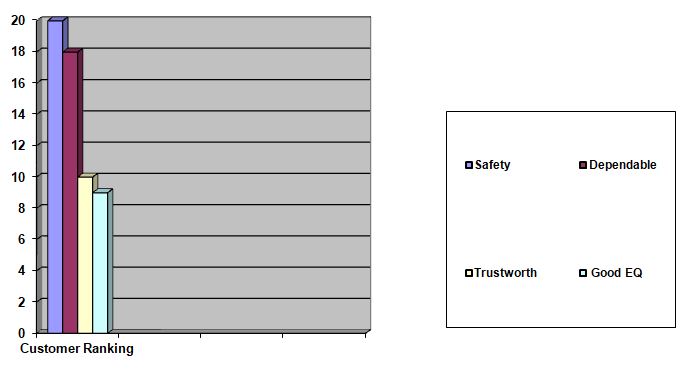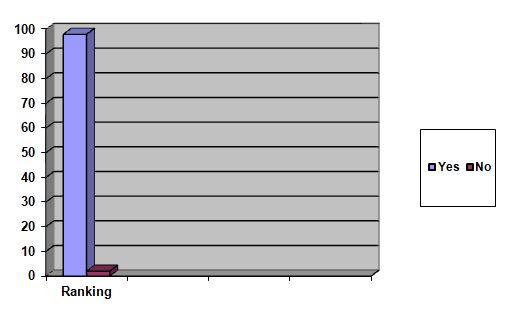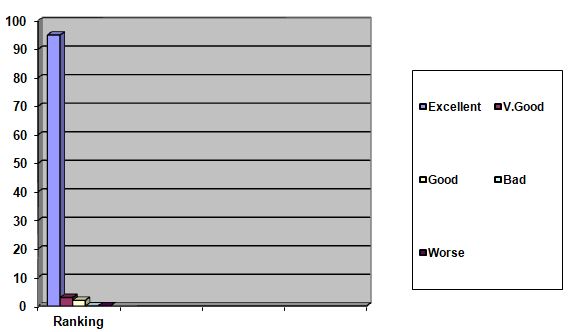Executive Summary
Sheikh Khalifa Medical city is a premier medical facility that offers high quality medical service to Middle East residents especially the UAE. The research sought to ascertain if the services offered by the facility meet the standards they are supposed to meet. This was done through a survey of the former and existing clients. A sample survey was used to collect the information that helped in the analysis and conclusions.
The results were very encouraging with only minor inconsistencies as far as service delivery in SKMC is concerned. That therefore was a vote of confidence in the leadership of the facility and a reminder that there is exists a challenge to maintain the same trend.
The researcher provides some recommendations which more or less center on the management of the hospital. These recommendations were drawn from the data that was analyzed. The management should therefore never take for granted their prime position rather, they should strive to improve the facility to meet the challenges they will come along.
Introduction of company (hospital)
This research study was carried out at Sheikh Khalifa Medical City, a premier hospital located in Abu Dhabi in the Middle East. Cleveland Clinic which is one of the biggest hospitals in the US manages the facility. SKMC came up a result of a merger of a number of medical facilities in the island of Abu Dhabi. The medical facilities that came together were all publicly held.
In its mission, the hospital is committed towards the provision of quality medical services by practicing modern medicine, using the best medical standards in the world as its benchmark. Customer satisfaction is ensured through the tailoring the services provided to meet the needs of the Abu Dhabi community. The hospital also ensures high levels of patient care while at the same time promoting the wellbeing of the community though education and awareness.
The facility boats of a bed capacity of 568 in the Acute Care Hospital, Outpatient Specialty Clinics together with a Blood Bank that have been accredited by the Joint Commission International. There are other facilities of the hospital that are yet to be accredited by JCI but are in line to meet the body’s standards. Besides the above facilities, SKMC manages a Behavioral sciences Pavilion, six clinics that provide family medicine, two centres that provide urgent care, and two centres dedicated to dental care.
In late 2009, SKMC’s Chest Pain Centre received an award as a cycle III chest pain centre. The award was the first awarded outside the US and only the twelfth in the world. This serves as a pointer to the high quality of services dispensed by SKMC. Cleveland Clinic aims to bring to SKMC the management style that is present in its facilities in the US while at the same time providing healthcare services that suit people of Abu Dhabi as well as the larger UAE and the Middle East.
The broader research is about the quality of medical services offered in Abu Dhabi. This particular research will focus on SKMC to determine the quality of services offered in the hospital and how UAE residents rate the services.
Methodology
The research will use the SERVIQUAL method. Zeithaml and Berry carried out extensive research in the mid eighties and came up with this method. Many scholars approve and use SERVIQUAL because of its effectiveness in evaluating customer service. Originally, SERVIQUAL included in its evaluation ten aspects that when evaluated, measured the service quality of organizations.
Customer experience and expectations were measured through ten aspects including, competency, responsiveness, reliability, communication, accessibility, customer understanding, credibility and the tangibles that the organizations had to offer. Over time however, the method has been modified to an acronym RATER.
Many scholars thought the original SERVIQUAL was too complicated and a simpler version would easily evaluate customer experience. The simpler version RATER stand for reliability, assurance of customers, tangibles, empathy and responsiveness.
Parasuraman, et al (1986) says that by using SERVIQUAL, organizations can be able to identify gaps that exist in their service delivery chain and also between the organization and the customers (p. 78). Sealing such gaps is critical to ensuring effective service delivery hence achieving high customer satisfaction.
According to Hill et al (2006) SERVIQUAL also helps in prioritizing the gaps to determine the relative impact of the services provided (p. 241). Besides, the method helps organizations uncover the sources or the reasons why the said gaps exists. According to Laws (2004), organizations are able to identify the root cause of the problems hence better able to address them.
After the problems have been identified and their origin determined, the method aids in formulating the remedies that will be taken to ensure the gaps are sealed and effective service delivery is achieved (89). Finally, the method helps organizations to put in place a system an evaluation system that continually reviews the service delivery standards of an organization to address the gaps that may be created from time to time due to market dynamics or needs of their clientele.
In this research study SERVIQUIAL will help us addressing the five commonest gaps that customer service and quality departments should bear in mind. The gaps include:
- The customer expectation and what managers think customers want. There is always a difference. The customer as the wearer of the shoe, so to say knows where it pinches. Manager may think they know what customers want but on the contrary, they know little.
- The other gap is in the perception of management and actual and existing customer experience. Organizations through their manager need to come clearly and define the level of service that their organizations want t offer.
- Another gap involves the experience specification. Organizations and their managers need to ensure that what is spelled out in their service delivery target bulletins is what is offered. If its not, then a gap exists that needs to be addressed.
- The fourth gap involves what is communicated to customers. Some managers and organizations choose to communicate only best cases that they have handled or the ‘ideal type’ kind of service. Customer expectations are raised while in actuality they do not get the described service. In some cases, customer perception is irreversibly damaged.
- The fifth gap that will be addressed by this research will involve the perception carried by the customer and the experience that they get. Because their perceptions are shaped by word of mouth and their own problems and experiences, it is important if organizations carry out routine surveys to determine of their customer’s expectations are met.
Research Design and Sample
This research was carried out in the Middle East. All the participants in the study were current of former customers of SKMC. Former here means that that have been treated in the hospital before. All participants were chosen randomly to eliminate bias with every participant having an equal chance of being selected. A sample survey involving five hundred participants was selected for the study. Both adults and children participated. Additionally, males and females participated in the study.
The average age for the children who participated in the study was 12 years while the average age of the adults who participated was 40 years. The number of females who participated in the study was slightly lower than that of males. Females numbered 150 while males were 250. One hundred children participated in the study. The variation of figures especially concerning women can be explained by cultural factors. Not many women were available for the study owing to the sometimes restrictive culture that exits in the Middle East.
The SERVIQUAL method was used through the administration of a questionnaire to the willing participants of the study. The questionnaires were available both in English and in Arabic though the content was the same. The questionnaire was administered face to face and none was administered remotely. Some researchers were stationed at the hospital while others traveled to the residences of the willing participants.
Research assistants assisted those who were willing to participate but could not read and write. The instructions were read to them clearly and they were expected to answer to affirmative or negative. Many of the children who participated could easily read and write in both languages. In a limited cases, researchers conducted interviews on the children similar to those conducted on the adults who could not read and write. The questionnaire acted as the guide to the interview.
All participants were well informed about the research and it was made clear form the beginning that participation was voluntary. They were also made to understand that after any analysis is done, they were not eligible to withdraw from the study. However anyone who felt the need to withdraw was free to do so before the data was analyzed and conclusions drawn.
Participants were made aware of their rights as spelt out in the ethics that underlay the research. Both researchers and participants were told of their respective codes of conduct. Above all the participants were assured of their privacy and confidentiality to which both parties committed in writing.
Presentation of results
The study sought to test the satisfaction of UAE residents who visit SKMC hospital. In essence, the study’s main aim was to uncover any gaps as described in the SERVIQUAL method to see so that meaningful measures can be taken to address them.
The distance existing between customer expectations and what managers think they expect
Generally, SKMC managers were found to understand their customers’ needs. However, there was a little discrepancy where some specific elements of services dispensed by SKMC were not in tandem with what the customers expect.
For instance, mangers thought customers needed to see up to date equipments, visually appealing structures well dressed, hospital employees, keeping of promises, sympathetic assuring staff, among others. A good number of managers though those visually appealing structures ranked high among what customers needed to see. In actuality, customers ranked it lower than the mangers expected.

Graph showing what customers want from SKMC.
Most of the expectations of customers are in tandem with what managers have always thought. The only difference was that a majority of managers ranked appealing visual structures a head of such elements as trust.
Management Perception and the actual specific formulation of customer experience
This particular gap aimed at determining if managers knew what the clients’ perception was and if they had their customer experience tailored to the level of service that was needed. The results pointed to an almost 100 percent correspondence between the SKMC management perception and their formulation of customer service levels.
On the same note, most of the managers of different facilities did not rank any element of service extremely higher than the other. Most were of the opinion that every element was important and worth pursuing to perfection. The ranking among customers did confirm the same

Graph ranking customer satisfaction on various issues in a scale of 1-10
NB: The above graph only shows some of the issues the elements that were ranked by the customers, not all of them.
Experience specification and delivery of the service/ experience
Most customers of SKMC interviewed agreed that they get what they are told by the institution. The organization has to take pride that what it promises their clients is what that get. The ranking is shown below

Graph showing customers get what they are promised.
It is important to note that the results in the above graph were not derived from one direct question specifically targeting the gap under study. Many more views that relate to delivery of promised service were analyzed to come up with the percentage response. Again, gap four which deals with the delivery of what is communicated to customers by the hospital was merged with gap three to produce the above result
Customer perception of service
This is some sort of referendum on the service that SKMC offers to its customers. After the delivery of the service, customers are bound to have their perceptions on the facility as well as the service. Through their analysis of their answers, the ranking by customers were as follows.

Graph showing perception of SKMC service by customers.
Discussion
From the above results is clear that a majority of the customers of SKMC are very satisfied with the service that they bet from the facility. Reliability, assurance, responsiveness, and delivery of tangibles are evident from the feedback that customers have given. Further more, the manager are very much on point when it comes to the management styles and policies geared towards meeting customer experience. However, it’s important to note that there were cases where some elements of customer service were ranked as good.
‘Good’ is not an indication of delivery of bad service. It means the mangers have some gaps to seal to raise the rank to excellent, where the majority of the clientele lies. The following recommendations/ suggestions therefore should be considered when making any managerial decisions about sealing the gaps.
Recommendations/ Suggestions
Concentrate on service: Majority of clients cited service above anything else. While its important to improve the aesthetic value and equipments of the facility, its important to note that personalized service is primary to the success of the facility. That not only include the medical staff that is in contact with the patients, but also the management that rarely meets the patients.
It is important for the management to take regular surveys to determine the perception of their services on their customers. Market trends and increasing consumer education is likely to affect their choice of service from time to time. Knowing what their customers think will therefore help in addressing the gaps that may come up at any given time.
SKMC should consider expanding its service beyond UAE borders. Though its may be part of the long-term strategy, it will be surprising for the management to know that their reputation soars beyond the UAE. This is a wake up call to the management to start exploring possible avenues to offer the service elsewhere.
Conclusion
SKMC should always remember that their customers are their assets and they should therefore treat them as such. Maintaining or continually improving the current level of service will ensure the lasting loyalty from their customer base.
References
Hill, et al. (2006) The handbook of customer satisfaction and loyalty measurement.Gower Publishing: London.
Laws, E. (2004) Improving tourism and hospitality services. CABI publishing: London.
Parasuraman et al. (1986) Servqual: a multiple item scale for measuring customer perceptions of service care. Marketing Science Institute: London.